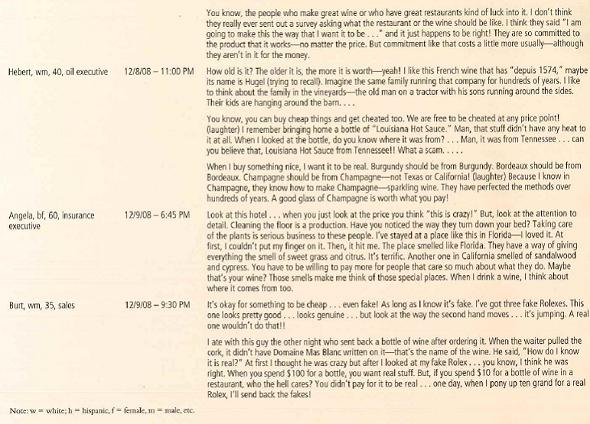Question
David Ortega is the lead researcher for an upscale restaurant group hoping to add another chain that would compete directly with the upscale Smith and
David Ortega is the lead researcher for an upscale restaurant group hoping to add another chain that would compete directly with the upscale Smith and Wollensky restaurants (http://www.smith-andwollensky.com). The Smith and Wollensky Restaurant Group operates a handful of iconic restaurants around the country. The average check for a customer at Smith and Wollensky is approximately $80 to $90.’ Whenever a new venture of this type is planned, one has to wonder whether there are enough customers willing to pay premium prices given the large number of lesser priced alternatives. In fact, David learns that Smith and Wollensky’ is giving some thought to opening a lesser priced “Grill” that would be positioned so that the average customer check would be about half that of the original. Maybe the best way to position the new restaurant group would be as a premium value offering high quality steaks and service but at a more modest price. What is it that people are willing to pay for and what sacrifices can be made to deliver a high value experience if not a luxurious experience? How can he create a unique experience at a lower price without falling into a mere dinner house category? These are the questions facing David Ortega.
RESEARCH APPROACH
After considering how to study the issue, David decides a qualitative research approach will be useful. He hopes to develop a deep understanding of how the fine dining experience offers value—and perhaps some insights into what intangibles create value for consumers in general. After considering the different options, he decides on a phenomenological approach. The primary tool of investigation is conversational interviewing. David plans to enter into casual conversations with businesspeople in the lounge of the downtown Ritz Carlton. He begins the conversation by commenting on the wine he is sipping—something like, “It isn’t bad, but it’s hard to believe they get $15 for just one glass of this stuff.”
RESULTS
Two weeks later, David has completed “conversations” with five consumers. He found them very willing and free to talk about the things they indulge in. He develops a field log of notes from the consumers’ comments. The notes are recorded verbatim.2 The following field notes are highlighted:


RESULTS
David decides to use a word count to try to identify the main themes. Hopefully, these themes can help clarify the business problem. Perhaps if the information can’t answer the questions above, it will point him in the right direction. Whatever the case, David feels the project has helped him better understand the total value proposition offered by restaurants, wines, hotels, and other products.
1. Comment on the research approach. Do you feel it was an appropriate choice?
2. ETHICS David did not inform these respondents that he was doing marketing research during these conversations. Why do you think he withheld this information and was it appropriate to do so?
3. ′NET Using the Internet, try to identify at least three restaurants that Smith and Wollensky competes with and three with whom the new S&W Grill may compete.
4. Try to interpret the discussions above. You may use one of the approaches discussed in the text. What themes should be coded? What themes occur most frequently? Can the different themes be linked together to form a unit of meaning?
5. What is the result of this research? What should David report back to the restaurant group?
Respondent Date/Time Text Joe, wm, 55, attomey 12/5/08 - 10:15 PM Well, wine doesn't have to be expensive to be good. Beyond some basic price point... maybe $14 a bottle. ..I find a lot of good wines. But, the wine has to fit the situation. It has to add something. A fake Rolex wil tel time; but a real Rolex tells you about you. I don't mind paying for something that's unique even though it might not be my cup of tea. Chateau Masur is like that. It's from Lebanon! It isn't always elegant or delicious, but it is always real. You always know it comes from some place very unique and is made under the most trying drcumstances. We pay too much for a lot of stuff though. I like things to be genuine. When you ask for crab you get crab-not Krab vrith a "K." It's made of fish you know!... I love old neighborhood italian restautants. They aren't always expensive. But, they have character. I think that it is very easy to spoil. I might not want a checkered red and white table cloth at home, but the Itallan restaurant has to have one. I have to smell the garlic from the parking lot. And, that cheap Chianti, the kind with the basket crade-it had better be from taly-it tastes so00 good there. You know, you could pay more, but a nice dinner there with a couple of friends is worth a lot. Sally, hf, 45, medical sales 12/7/08 -5:45 PM
Step by Step Solution
3.44 Rating (160 Votes )
There are 3 Steps involved in it
Step: 1
1 The srt f mrketing reserh Dvid used ws desritive reserh sine he ws trying t int n imge f the fine dining exeriene nd the vlue nsumers view in intngibles suh s eting t resturnt He hse t use qulittive ...
Get Instant Access to Expert-Tailored Solutions
See step-by-step solutions with expert insights and AI powered tools for academic success
Step: 2

Step: 3

Ace Your Homework with AI
Get the answers you need in no time with our AI-driven, step-by-step assistance
Get Started


